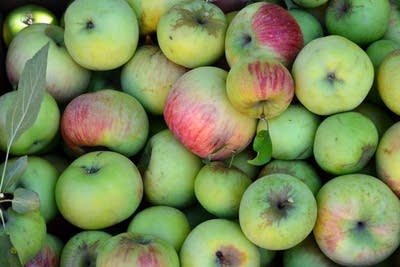'Gleaners' collect unharvested produce to help feed hungry
Go Deeper.
Create an account or log in to save stories.
Like this?
Thanks for liking this story! We have added it to a list of your favorite stories.

When Mike Struck answered a knock at his front door, he found a short man with a shock of gray hair - a man very interested in his two apple trees.
"I thought, who is this guy?" Struck recalled.
Peter Martignacco is accustomed to quizzical looks. As a volunteer neighborhood coordinator for the gleaning program Fruits of the City, which collects unharvested fruit from orchards and homes that would otherwise go to waste, he drives around northwest Twin Cities suburbs hunting for fruit trees and knocking on doors. He'd been eyeing the trees for weeks, wondering if the homeowner might donate his excess fruit to people in need. Struck quickly agreed.
"You can only eat so many apples," said Struck, who dehydrates the fruit for snacks. "Especially in a year like this, where there's a ton of them. Most of them would probably drop. The deer come through and eat what's on the ground. Makes sense to put 'em to use."
Turn Up Your Support
MPR News helps you turn down the noise and build shared understanding. Turn up your support for this public resource and keep trusted journalism accessible to all.
Fruits of the City is part of a growing effort in Minnesota to collect excess crops that would otherwise rot in the fields or wind up in a compost bin. Increasingly, food banks pick up surplus vegetables at farmers markets and local gardeners donate their extra tomatoes or green beans. A new campaign to rescue unharvested Minnesota sweet corn aims to collect more than 1 million pounds this year and get it on the plates of needy families across the nation.

Struck's consent triggered an email and social media blast to gleaners in the area -- and anyone else willing to meet at a random address on a Friday morning to pick apples. A group of eight special needs students from the Minneapolis Public Schools responded. The students joined Fruits of the City organizers at three Brooklyn Park homes, including Struck's. Two and a half hours later, they'd picked 360 pounds of fruit.
On late fall days, gleaners with Fruits of the City, a program of the nonprofit The Minnesota Project, fan out across the Twin Cities metro area to pick apples and pears that would otherwise go uneaten and donate them to hunger relief groups. Armed with apple picking poles and Goggle maps, they wind their way from neighborhood to neighborhood. Since its start in 2008, the program has grown significantly. This year volunteers will work in 15 orchards and as many as 200 backyards. Organizers have already surpassed last year's total of nearly 40,000 pounds.
"There's a lot of fruit out there that wouldn't get harvested otherwise," said Fruits of the City gleaning manager Jared Walhowe. "A single apple tree can produce hundreds of pounds of fruit, much more than many of the tree owners can use."
Some homeowners are away at work when volunteers pick their trees. Some watch from their windows. Others, like Struck, grab an apple picker and climb a ladder to help.

Walhowe estimates his group collects only a small fraction of the excess fruit in Minnesota. A study by the Boston Consulting Group estimates 210 million pounds of sweet corn, potatoes, and peas go unharvested in the state each year.
The efforts to harvest such foods coincide with a nationwide shift at food shelves, which are seeking new, healthier sources of food as traditional donations decline. For example, food shelves receive fewer nonperishable donations from big food manufacturers, which have grown more efficient.
"If you think of a food shelf, you might think of canned foods," Walhowe said. "This is one way we can get healthy, fresh food into the food shelves."
Apples are especially prized, Walhowe said, because they last months if refrigerated.

After the morning of apple picking, Walhowe delivered 12 boxes of fruit to the CEAP food shelf in Brooklyn Center. CEAP President Byron Laher has been pushing hard for more produce. He said a recent study conducted by St. Paul's Keystone Community Services, which found its food shelf clients have twice the national average of diabetes, grabbed his attention.
"It was kind of an awakening for all of us that we need to provide more fresh food -- for everybody, not just those with a disease -- to help them live better," Laher said. "It addresses the obesity issue as well as everything else."
A few years ago, CEAP gave clients almost no fresh produce. Now, fruits and vegetables make up half of the food given to each family. Laher said such produce can be unaffordable for people struggling to put food on the table.
"That gets pricey for them," he said. "We've said to families, 'We'll get you stuff that's tough to afford at the grocery store. You can buy the stuff that goes on sale.'"
Fruits of the City recently received a $5,000 grant from Hunger-Free Minnesota to expand the effort to Stillwater, Morris, and New London.
The group, which is seeking volunteers, will be picking apples through the end of October. Organizers expect to glean at several orchards before the season ends.





